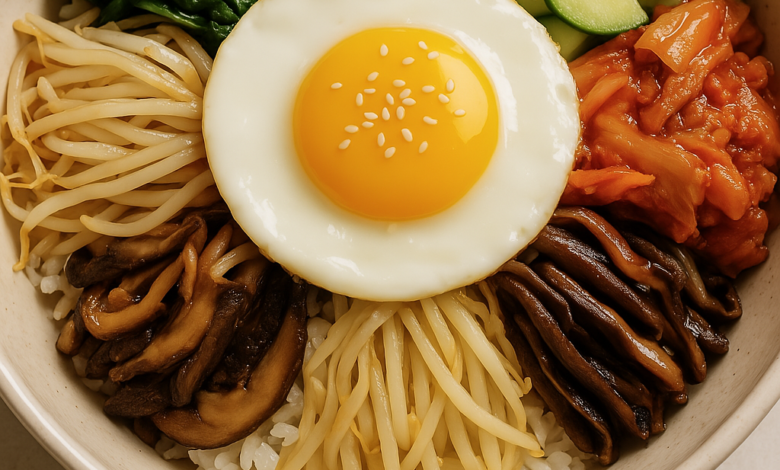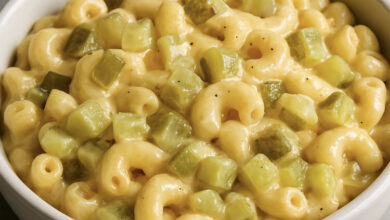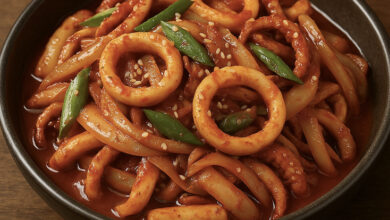Bibimbap: The Ultimate Korean Comfort Bowl

What Is Bibimbap?
Bibimbap (비빔밥), meaning “mixed rice” in Korean, is one of Korea’s most iconic dishes. This vibrant and nutritious bowl consists of steamed rice topped with an assortment of sautéed vegetables, marinated meat, fried egg, and a spicy-sweet gochujang (Korean red chili paste) sauce. The beauty of bibimbap lies in its balanced flavors, textural contrast, and its ability to be customized to personal tastes.
The History of Bibimbap
Bibimbap has a rich history dating back centuries, often associated with royal cuisine and traditional Korean holidays. Originally, it was a way to use up leftover side dishes (banchan) by mixing them with rice and sauce. Today, it has evolved into a globally loved dish, found in casual Korean eateries and high-end restaurants alike.
Ingredients for Authentic Bibimbap
Main Components:
- Steamed Rice: 2 cups of short-grain white rice (or brown rice for a healthier version)
- Marinated Meat: ½ pound of sliced beef (ribeye or sirloin), chicken, or tofu for a vegetarian option
Vegetable Toppings (Customizable):
- Spinach: 1 cup, blanched and seasoned with sesame oil and salt
- Carrots: ½ cup, julienned and sautéed lightly
- Zucchini: ½ cup, julienned and stir-fried
- Bean Sprouts: 1 cup, blanched and lightly seasoned
- Mushrooms: ½ cup, shiitake or button mushrooms, sliced and sautéed
- Kimchi: ½ cup, for a tangy, fermented flavor
Other Essential Ingredients:
- Egg: 1 fried egg (sunny-side-up) per serving
- Gochujang Sauce:
- 2 tablespoons gochujang (Korean red chili paste)
- 1 tablespoon sesame oil
- 1 tablespoon rice vinegar
- 1 teaspoon honey or sugar
- 1 teaspoon soy sauce
- 1 teaspoon sesame seeds
For Garnish:
- Sesame Seeds: 1 tablespoon
- Green Onions: 2 tablespoons, finely chopped
- Nori (Seaweed) Strips: Optional for extra umami flavor
How to Make Bibimbap
Step 1: Prepare the Rice
Cook the short-grain rice according to package instructions. For the best texture, use slightly sticky rice, which helps bind the ingredients together when mixed.
Step 2: Marinate and Cook the Meat
- In a bowl, mix 2 tablespoons of soy sauce, 1 teaspoon of sesame oil, 1 teaspoon of honey, and 1 clove of minced garlic.
- Add sliced beef (or tofu for a vegetarian option) and marinate for at least 15 minutes.
- Heat a pan over medium heat and cook the beef until fully browned. Set aside.
Step 3: Prepare the Vegetables
Each vegetable should be cooked separately to maintain its unique flavor and texture.
- Sauté julienned carrots, zucchini, and mushrooms in a little sesame oil, seasoning lightly with salt.
- Blanch spinach and bean sprouts in boiling water for 1 minute, then drain and toss with a dash of sesame oil and salt.
- Set each vegetable aside in separate sections to maintain their vibrant colors.
Step 4: Make the Gochujang Sauce
In a small bowl, whisk together gochujang, sesame oil, rice vinegar, honey, soy sauce, and sesame seeds. Adjust spice level by adding more or less gochujang.
Step 5: Fry the Egg
Cook an egg sunny-side-up so the yolk remains runny. The yolk helps create a rich, creamy texture when mixed into the bowl.
Step 6: Assemble the Bibimbap
- In a large bowl, place a serving of cooked rice at the bottom.
- Arrange the sautéed vegetables, marinated meat, and kimchi in sections on top of the rice.
- Place the fried egg in the center.
- Drizzle with gochujang sauce and sprinkle sesame seeds and green onions on top.
Step 7: Mix and Enjoy
Before eating, mix everything together to evenly distribute the flavors. The combination of spicy, savory, tangy, and umami flavors makes every bite incredibly satisfying.
Tips for the Best Bibimbap
- Customize It: Feel free to swap out vegetables based on what you have available. Avocado, bell peppers, or shredded cabbage are great additions.
- Spice Level: Adjust the amount of gochujang sauce to control the heat level.
- Serving Style: For an extra crispy texture, serve bibimbap in a hot stone bowl (dolsot bibimbap), which creates a crunchy rice crust at the bottom.
Health Benefits of Bibimbap
Bibimbap is not only delicious but also packed with nutrients:
- High in Protein: The egg and meat provide essential proteins.
- Rich in Fiber: The variety of vegetables aids digestion.
- Balanced Meal: Contains healthy carbs, fats, and proteins in one bowl.
Final Thoughts
Bibimbap is the perfect dish for those who crave a nutritious, colorful, and deeply flavorful meal. Whether you’re making it at home or ordering it at a Korean restaurant, this dish is a true culinary delight that embodies the best of Korean cuisine. Try it today and experience a harmony of flavors in every bite!





